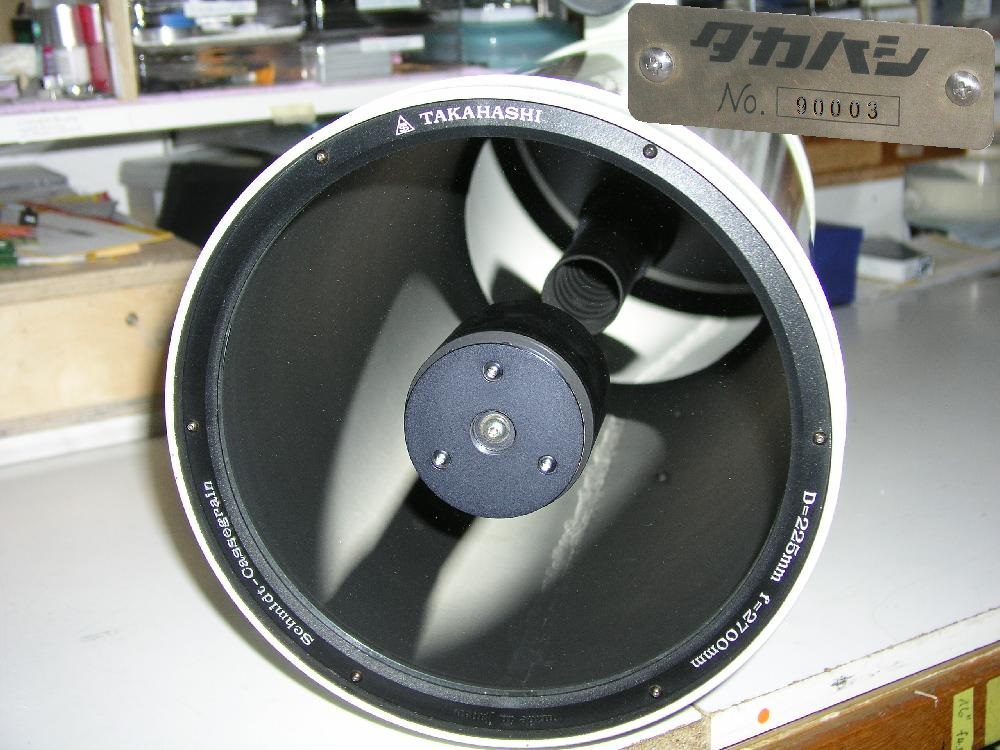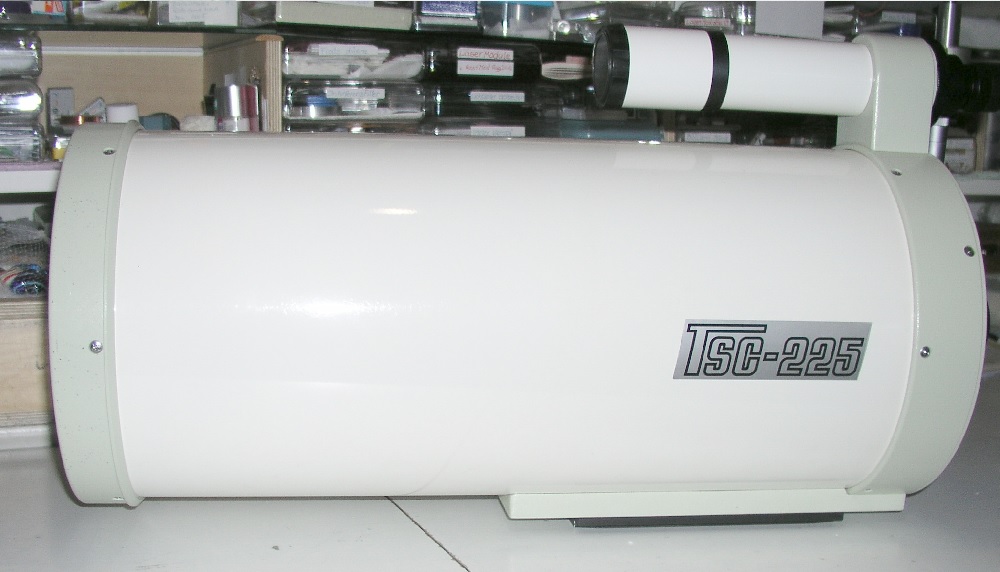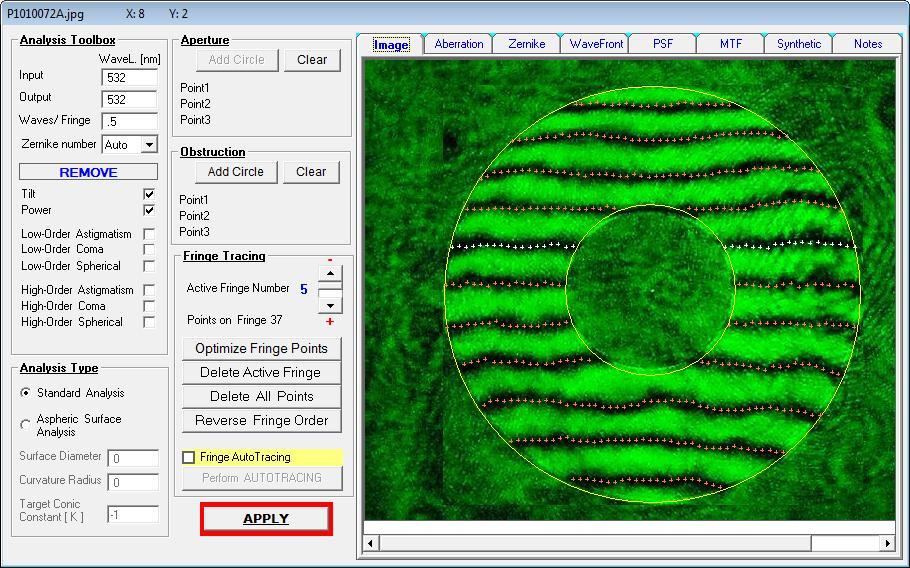D049A Takahashi TSC - Schmidt-Cassegrain 225-2700 F12
eine Art Vorwort . . .
- die sphärische Abweichung liegt unter PV L/15
- das RonchiBild zeigt die Abweichung hinsichtlich sphärische Abweichung
- der Lyot-Test zeigt, daß auch Takahashi Floatglas-Scheiben für die Schmidtplatte benutzt, ähnlich wie Meade und Celstron
System ist die Schmidtplatte und die Sekundärspiegel-Retouche die Ursache für die "Rauhheit" des Systems. Der 3-eckige
Astigmatismus wäre ein Rest-Fehler der HS-Lagerung und stört in keiner Weise, auch wenn er meßtechnisch nachweisbar ist.
Einen Farblängsfehler, noch mehr einen Gaußfehler hat dieses SC nicht - gut erkennbar am Foucault-Bild - siehe letztes Bild.

.
Anders als bei Celstron und Meade SC-Systemen hat dieses hier ein Öffnungsverhältnis von F/12.

.
Hier kann man mit anderen SC-Systemen vergleichen:

.
Bei einer Vergrößerung von 1500 - der Normalfall wäre ca. 300-fach - läßt sich jeder noch so kleine Restfehler darstellen. Zur Beurteiluung lassen sich zwei Argumente
anführen: Ein 3-eckiger Trifoil/Astigmatismus läßt sich weniger gut wahrnehmen, als Astigmatismus der Grundordnung Z04 und Z05. Auch liegt sein Wert mit
PV L/4.6 unter der Wahnnehmuungs-Schwelle. Aber er reduziert den Strehlwert, wer sich darauf konzentriert. Da aber die Schmidtplatte ebenfalls aus Floatglas
hergestellt wurde, und der Sekundär-Spiegel retouchiert wurde, hat diese SC-System die Merkmale vieler anderer Systeme. Ein Öffnungsverhältnis von F/12 ist bei
diesem System durchaus sinnvoll.

.
Auch die Point Spread Function bildet diesen Trefoil-Astigmatismus ab - eigentlich ein unbedeutender Restfehler.
Das Referenz Interferogramm bei 532 nm wave

.
Die 3D-Wellenfront-Darstellung

.
Und die differenzierte Rest-Fehler-Analyse:
- Astigmatismus unter der Wahrnehmungsschwelle mit PV L/4.6
- perfekte Zentrierung mit PV L/24
- Wert für Spherical mit PV L/15.6
- bei Abzug von Astigmatismus Strehl = 0.978
.

Zum Vergleich mit anderen SC-Systemen: D024 - Kap 04 Vergleich von SC-Systemen über Foucault- und Lyot-Test
am farbigen Foucault-Bild läßt sich bei SC-Systemen ein geringer Farblängsfehler, aber ein deutlicher Gaußfehler ablesen. Das TSC 225
zeigt in dieser Hinsicht kaum einen Farbfehler. Meade-SC's bzw. Celestron SC's sind meist im grünen Spektrum überkorrigiert,
was man besonders am Foucault-Bild erkennen kann.

.
.
Kommentare
But why was the Foucault test on this TSC225 done whilst the primary mirror was still cooling? I can see a rather obvious thermal plume in the image? The mirror's shape is usually different whilst it is cooling, and should not be tested until fully at ambient temperature (i.e. no thermal plume visible at all, at 700x for example, on an artificial star).
Also I can see a thermal plume on the Phase-Contrast type test on the right of the Foucault test image. Was there still a thermal plume when you did the Ronchigram? In which case all of these tests that I mention become null and void, which is a great pity.
Was the Ronchigram done in AutoCollimation (where the errors are doubled) or with a point source from far in front of the instrument (no reference flat mirror used) ?
I am a little surprised and disappointed at Takahashi's optics (assuming that you tested in Autocollimation for the Interferogram when the primary mirror no longer showed ANY thermal plume AT HIGH MAGNIFICATION e.g. 700x, and also assuming that you are taking into account - in your software - the doubling of the errors through the instrument because of testing in Autocollimation for the Interferogram) since Tak's optics are supposed to be 1/20 lambda PV or better ! "The precision of optical surfaces is at least of λ/20" - see quote here ;-
http://www.takahashi-europe.com/en/mewlon.features.php . And these Tak SCT's were 4,000 USD when on sale in the 1990's (they only made 100 of them), way more expensive than my C11 SCT.
From this test I see no reason to think that Tak's optics are any better (in smoothness or surface accuracy) than a good Celestron Edge HD or Meade ACF. Tak's instruments are way overpriced, for not much or any better optics quality IMHO.
Regards,
Alistair G.
Alle Kommentare dieses Beitrages als RSS-Feed.